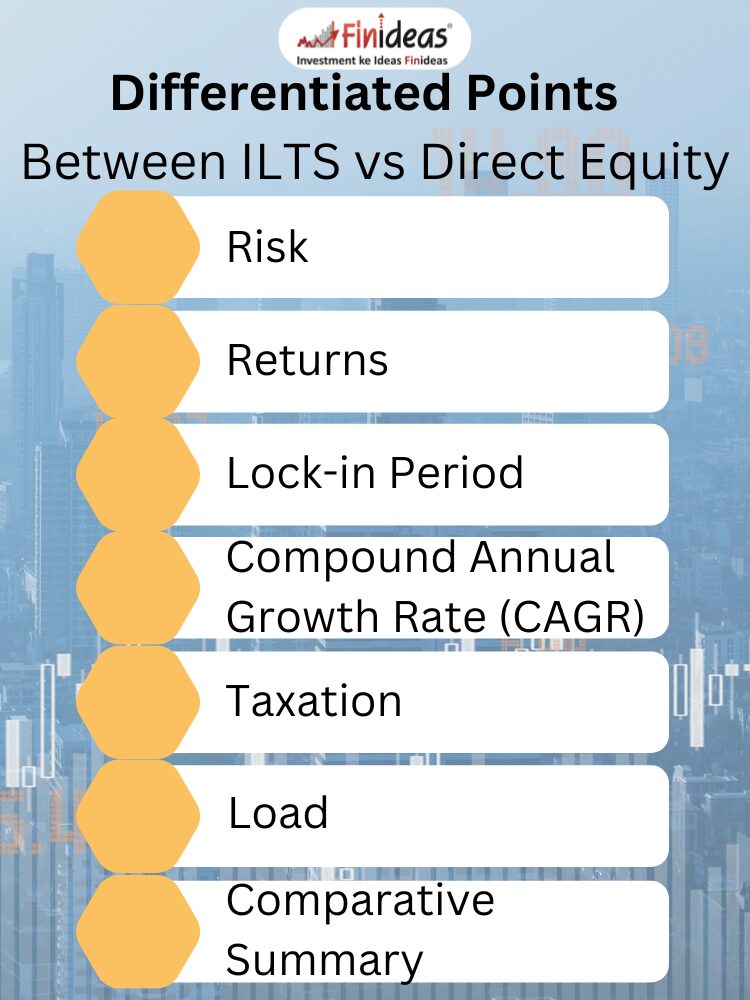ILTS vs. Direct Equity: Which Investment Strategy Suits You Best?
Investing wisely requires understanding the various options available and how they align with your financial goals and risk tolerance. Two popular investment strategies are the Index Long Term Strategy (ILTS) and Direct Equity. Let’s delve into a detailed comparison between these two approaches across several key aspects.
What is Risk?
- ILTS:
Index Long Term Strategy carries a lower risk profile, rated at just 4%. This reduced risk is primarily due to its diversified portfolio, which spreads investments across various stocks within an index. Additionally, the use of hedging through options further mitigates potential losses. While not entirely risk-free, ILTS is significantly safer compared to individual stock investments.
- Direct Equity:
Investing directly in individual stocks is associated with a much higher risk, rated at 100%. This high risk comes from the exposure to specific risks of the companies chosen, including market volatility, industry challenges, and company-specific factors. Therefore, Direct Equity requires a higher risk tolerance from investors.
2. What are Returns?
- ILTS:
ILTS offers the potential for unlimited returns. By tracking an entire index, it captures the overall market movement, which can result in substantial returns over the long term.
- Direct Equity:
Similar to ILTS, Direct Equity also provides the possibility of unlimited returns. However, the actual returns are highly dependent on the performance of the individual stocks selected by the investor. Hence, the potential for high returns is coupled with high risk.
3. What is the Compound Annual Growth Rate (CAGR)?
- ILTS:
The Compound Annual Growth Rate for ILTS is 18%, reflecting its strong historical performance and ability to deliver compounded annual growth over the long term.
- Direct Equity:
For Direct Equity, specifically tracking an index, the CAGR stands at 14%. This rate is influenced by the collective performance of the stocks within the chosen index.
4. What is the Lock-in Period?
- ILTS:
One of the advantages of ILTS is the absence of a lock-in period. Investors can buy and sell their holdings at any time, offering significant liquidity and ease of portfolio management.
- Direct Equity:
Similarly, Direct Equity investments generally do not have a lock-in period. Investors have the flexibility to enter or exit their positions based on their investment strategy and market conditions.
5. What is Taxation?
- ILTS:
Taxation for ILTS primarily involves Long-Term Capital Gains (LTCG) and business income. The gains are subject to tax based on the holding period and prevailing tax regulations.
- Direct Equity:
Taxation in Direct Equity is also in the form of Long-Term Capital Gains (LTCG). The tax treatment is applied to the profits generated from the sale of equity shares held for a specified period.
6. What is Load?
- ILTS:
Typically, ILTS does not have entry or exit loads. This means investors can enter or exit the investment without incurring additional charges, providing greater flexibility.
- Direct Equity:
While there is generally no entry load in Direct Equity, exit loads may apply, especially if the investor exits within a specified period. This cost should be taken into account when evaluating overall returns.
7. Comparative Summary
To provide a clearer comparison, here is a summary table highlighting the key aspects:
Aspect | Index Long Term Strategy (ILTS) | Direct Equity |
Risk | 4% | 100% |
Returns | Unlimited | Unlimited |
CAGR | 18% | 14% (Index) |
Lock-in Period | No Lock-in | No Lock-in |
Taxation | Major Part LTCG | LTCG |
Load | No Entry/Exit Load | Exit Load |
Conclusion
The choice between Index Long Term Strategy (ILTS) and Direct Equity depends on your risk appetite, preference for diversification, and investment goals. ILTS offers a more diversified and relatively lower-risk approach, ideal for investors looking for stability and steady growth. On the other hand, Direct Equity allows for individual stock selection, which can potentially yield higher returns but comes with higher risk.
Investors should carefully consider their risk tolerance and investment strategy before making a decision. By understanding the nuances of each approach, you can make an informed choice that aligns with your financial objectives.
Happy Investing!
This article is for education purpose only. Kindly consult with your financial advisor before doing any kind of investment..




